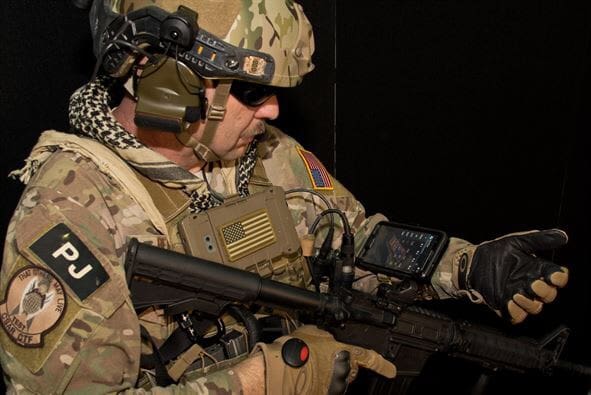
Chief Master Sgt. Robert Bean, an Air Force pararescue jumper, demonstrates how BATDOK can be worn on the wrist, providing awareness of the health status of multiple patients. Developing BATDOK required Air Force medical researchers to embed with pararescue jumpers on live missions to ensure the tool met the rigorous standards required by combat Airmen.
FALLS CHURCH, Va. — Imagine the chaos and challenge of delivering life-saving care in a battlefield environment. That’s what faced a group of Air Force researchers as they developed a new electronic patient monitoring tool for use on the battlefield. Overcoming this challenge required an integrated development process, where the researchers left the lab, and embedded on missions with medical Airmen.
The technology they developed, the Battlefield Assisted Trauma Distributed Observation Kit, or BATDOK, is software than can run on a smartphone or other mobile devices, and draws patient information from a wide variety of commercially available, U.S. Food and Drug Administration approved sensors. It lets medics monitor multiple patients in the field, seeing vital information and managing multiple patients in a chaotic environment.
The integrated development process was critical to making BATDOK a tool that seamlessly integrates mobile capabilities for Airmen in the field, said Dr. Gregory Burnett, of the Airman Systems Directorate in the Warfighter Interface Division of the 711th Human Performance Wing. Dr. Burnett managed the development of BATDOK for the Air Force.
“BATDOK is a multi-patient, point of injury, casualty tool that assists our human operators and improves care,” said Burnett. “It can be a real-time health status monitoring for multiple patients, a documentation tool, a user-definable medical library, a portal to integrate patient data into their electronic health records, and finally it is interoperable with battlefield digital situation awareness maps, which helps identify the exact location of casualties.”
Dr. Burnett’s background is in computer engineering, with an emphasis in embedded electronics and mobile interfaces. This theoretical knowledge helped the Air Force Research Laboratory development team design the look and feel of BATDOK, but more intimate knowledge was needed for the tool to be most useful for operators in the field.
“We physically left the lab, got into the field with the operators, and observed firsthand the challenges and deficiencies they face,” said Burnett. “And when I say into the field, I mean we literally rode in the helicopters into hot landing zones, and observed medical Airmen stabilize and package up patients for transport and load them back on the helicopter.
“We see, at the point of injury, the challenges and limitations that our medical Airmen face. With those lessons learned and gaps identified through direct experience, we come back to the lab and devise innovative solutions to address the short falls we observed firsthand in the field.”
The integration didn’t stop once the BATDOK development team got back to their lab. They continued to interact with the operators from their deployment, and got their feedback throughout the process.
“From day one, every interface, every button, every menu, was user-validated by pararescue Airmen and combat rescue officers that were involved in the design, integration and testing process,” said Burnett. “Nothing is added without the explicit request and review by the operator.”
This brings first firsthand knowledge to the development process. The development team and the operators sit down and walk through the mission step-by-step. They identify areas where current technology can be improved, or where a gap exists, and then share ideas to innovate new solutions and capabilities.
This process helps the team identify requirements and avoid unforeseen downsides to new technology. Medical Airmen deploy with heavy loads, so can be cautious about adding new gear. Working so closely with the operator helps the team integrate BATDOK into the tactical ensemble.
“BATDOK was designed to not add any additional burden to battlefield Airmen’s tactical ensemble,” said Burnett. “From the beginning, we are designing to enhance capabilities, while aiding their survivability and lethality.”
“Being part of the Air Force gives us flexibility and firsthand, unfiltered access to operators and perspective on the challenges that Airmen face. This is true for both humanitarian and combat missions. Being able to observe in person is invaluable, and helps us contribute to the overall readiness mission.”
By Peter Holstein, Air Force Surgeon General Office of Public Affairs


So…. the medic carries a device that magically monitors vitals?
Obviously he needs to apply some type of device to the patient or else every soldier, airman, sailor, and marine will need to be already wearing said devices. Putting a device on in the bird flying to the FAST, sure, but they have those devices on the helos.
Having a medical library at the poi? Do you check out “how to dress a facial lac” from behind cover?
I guess I don’t see the benefits for this device beyond costing a metric butt ton of money. Am I missing a bigger picture here? A top to bottom integrated system that will save more lives? I’d be willing to bet the statistics of soldiers dying because someone forgot to check vitals are infinitely small.
???
I’ve only got civilian medical experience but I think the aim is to keep better track of multiple patients’ status. Pulse ox readings, blood pressure, meds administered, etc. all with time stamps for each patient. If you’ve got multiple people injured and patient 3’s o2 sat slowly slipped from 98 to 96 to 95 in the last 10 minutes, you’ll see that, drop what you’re doing and check on them. That’s what I think they’re trying to accomplish.
This technology would be invaluable for extended field care scenarios. Your regular snatch and grab casevac type situations might happen too quickly to fully stretch the legs of this tech but I would have loved for something like this out in the bush.